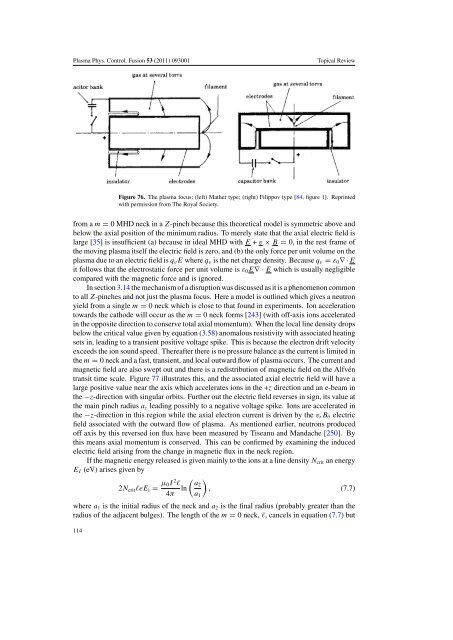Create successful ePaper yourself
Turn your PDF publications into a flip-book with our unique Google optimized e-Paper software.
Plasma Phys. Control. Fusion 53 (2011) 093001<br />
Topical Review<br />
Figure 76. The plasma focus; (left) Ma<strong>the</strong>r type; (right) Filippov type [84, figure 1]. Reprinted<br />
with permission from The Royal Society.<br />
from a m = 0 MHD neck in a Z-<strong>pinch</strong> because this <strong>the</strong>oretical model is symmetric above and<br />
below <strong>the</strong> axial position <strong>of</strong> <strong>the</strong> minimum radius. To merely state that <strong>the</strong> axial electric field is<br />
large [35] is insufficient (a) because in ideal MHD with E + v × B = 0, in <strong>the</strong> rest frame <strong>of</strong><br />
<strong>the</strong> moving plasma itself <strong>the</strong> electric field is zero, and (b) <strong>the</strong> only force per unit volume on <strong>the</strong><br />
plasma due to an electric field is q v E where q v is <strong>the</strong> net charge density. Because q v = ε 0 ∇·E<br />
it follows that <strong>the</strong> electrostatic force per unit volume is ε 0 E∇·E which is usually negligible<br />
compared with <strong>the</strong> magnetic force and is ignored.<br />
In section 3.14 <strong>the</strong> mechanism <strong>of</strong> a disruption was discussed as it is a phenomenon common<br />
to all Z-<strong>pinch</strong>es and not just <strong>the</strong> plasma focus. Here a model is outlined which gives a neutron<br />
yield from a single m = 0 neck which is close to that found in experiments. Ion acceleration<br />
towards <strong>the</strong> cathode will occur as <strong>the</strong> m = 0 neck forms [243] (with <strong>of</strong>f-axis ions accelerated<br />
in <strong>the</strong> opposite direction to conserve total axial momentum). When <strong>the</strong> local line density drops<br />
below <strong>the</strong> critical value given by equation (3.58) anomalous resistivity with associated heating<br />
sets in, leading to a transient positive voltage spike. This is because <strong>the</strong> electron drift velocity<br />
exceeds <strong>the</strong> ion sound speed. Thereafter <strong>the</strong>re is no pressure balance as <strong>the</strong> current is limited in<br />
<strong>the</strong> m = 0 neck and a fast, transient, and local outward flow <strong>of</strong> plasma occurs. The current and<br />
magnetic field are also swept out and <strong>the</strong>re is a redistribution <strong>of</strong> magnetic field on <strong>the</strong> Alfvén<br />
transit time scale. Figure 77 illustrates this, and <strong>the</strong> associated axial electric field will have a<br />
large positive value near <strong>the</strong> axis which accelerates ions in <strong>the</strong> +z direction and an e-beam in<br />
<strong>the</strong> −z-direction with singular orbits. Fur<strong>the</strong>r out <strong>the</strong> electric field reverses in sign, its value at<br />
<strong>the</strong> main <strong>pinch</strong> radius a z leading possibly to a negative voltage spike. Ions are accelerated in<br />
<strong>the</strong> −z-direction in this region while <strong>the</strong> axial electron current is driven by <strong>the</strong> v r B θ electric<br />
field associated with <strong>the</strong> outward flow <strong>of</strong> plasma. As mentioned earlier, neutrons produced<br />
<strong>of</strong>f axis by this reversed ion flux have been measured by Tiseanu and Mandache [250]. By<br />
this means axial momentum is conserved. This can be confirmed by examining <strong>the</strong> induced<br />
electric field arising from <strong>the</strong> change in magnetic flux in <strong>the</strong> neck region.<br />
If <strong>the</strong> magnetic energy released is given mainly to <strong>the</strong> ions at a line density N crit an energy<br />
E I (eV) arises given by<br />
2N crit leE i = µ 0I 2 ( )<br />
l<br />
4π<br />
ln a2<br />
, (7.7)<br />
a 1<br />
where a 1 is <strong>the</strong> initial radius <strong>of</strong> <strong>the</strong> neck and a 2 is <strong>the</strong> final radius (probably greater than <strong>the</strong><br />
radius <strong>of</strong> <strong>the</strong> adjacent bulges). The length <strong>of</strong> <strong>the</strong> m = 0 neck, l, cancels in equation (7.7) but<br />
114














